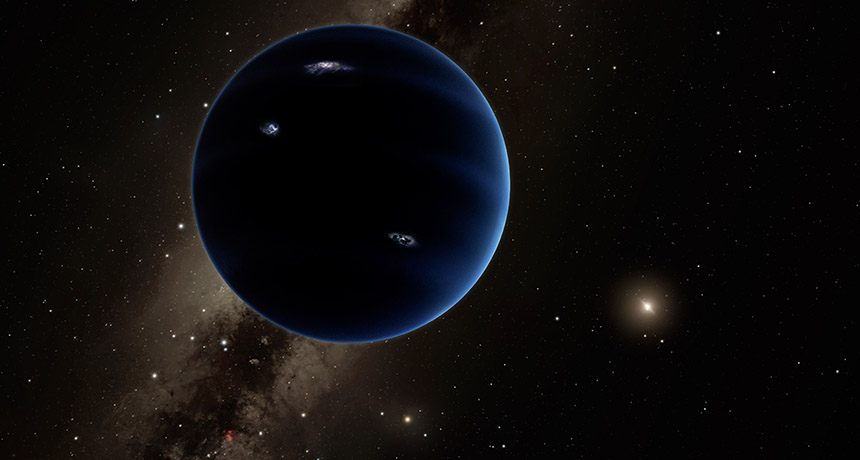Beyond Pluto: A new 9th planet?
It would just be way bigger, way further out and still waiting to be seen

A mystery planet may orbit the sun from the far reaches of the Kuiper Belt.
CALTECH/R. HURT (IPAC)
An unseen planet may be hiding in the outskirts of our solar system. Planetary scientists have just projected its existence based on oddities in the orbits of some far-flung icy bodies. Those tiny objects reside in the distant Kuiper (KY-pur) belt — a vast expanse of space beyond the orbit of Neptune.
Konstantin Batygin and Michael Brown work at Caltech in Pasadena, Calif. Their new calculations suggest this new mystery world would be roughly 10 times as massive as Earth. And if it exists, it must travel a highly elongated orbit.
Astronomers refer to Earth’s average distance from the sun as one “astronomical unit,” or AU. The scientists are not sure how far away this new ninth planet would be. But their calculations indicate it should be somewhere between 400 to 1,500 AU. For those keeping score, that’s about 60 billion to 220 billion kilometers (37.3 billion to 136.7 billion miles) from the sun.
PLANET X Planetary scientists Konstantin Batygin and Michael Brown discuss the latest evidence of a hidden ninth planet orbiting along the outskirts of our solar system. Caltech AMT |
Batygin and Brown described how they came to that assessment in a paper published early online, January 20, in Astronomical Journal.
They are not the first to suspect there might be a true ninth planet. In March 2014, two other researchers noticed that a dozen objects, all far beyond Neptune, crossed the plane of the solar system at roughly the same point in their orbits. It was as they were making their closest approach to the sun.
That plane is an imaginary surface going through the sun and the orbits of the major planets. Over billions of years, interactions with the known giant planets — Jupiter, Saturn and Uranus — should have randomized where in those orbits the rocky objects crossed that plane. The probability of them all crossing the plane at this same point in their orbits by chance is just 0.007 percent, the Caltech team now reports.
But, they add, a planet patrolling the borderlands of the solar system could shepherd all of those rocky bodies to cross the plane at the same point in their orbits. Indeed, that’s a major argument that Batygin and Brown now offer for the existence of a giant mystery planet.
The new Caltech study seems to “make this super-Earth sized planet a much more real possibility,” says Scott Sheppard. He’s a planetary scientist at the Carnegie Institution for Science in Washington, D.C. He also co-authored the 2014 paper that had suggested a ninth planet might exist.
Such a remote super-Earth probably started out much closer to the sun. It likely got kicked out by the other giant planets during the solar system’s formative years, Batygin and Brown now suspect.
Ironically, it was Brown’s 2005 discovery of larger-than-Pluto objects in the Kuiper belt that kicked off the discussions about whether Pluto was actually a planet. In the end, Pluto was demoted. It is now considered a somewhat different object: a “dwarf planet.”
Brown noted that his daughter was very young when Pluto got demoted and blamed her dad. “[S]he suggested a few years ago that she’d forgive me if I found a new planet,” he told the Washington Post. “So I guess I’ve been working on this for her.”







